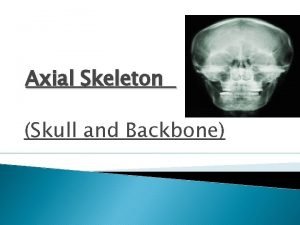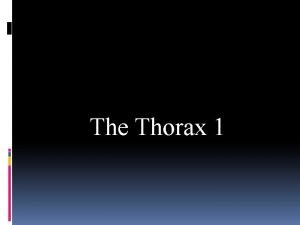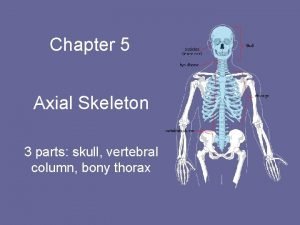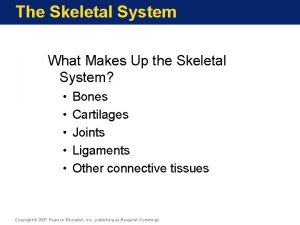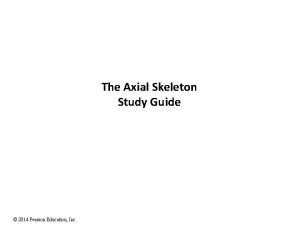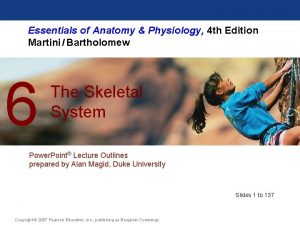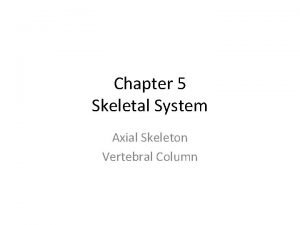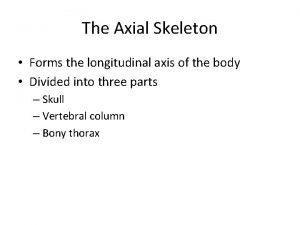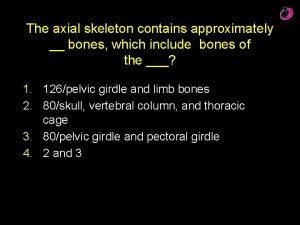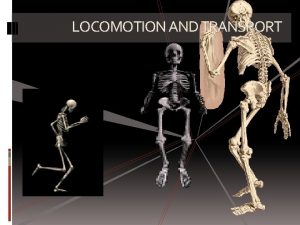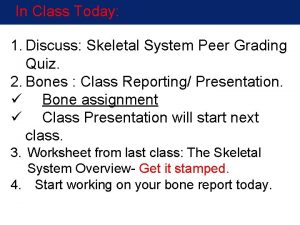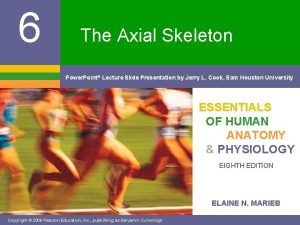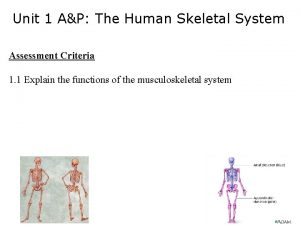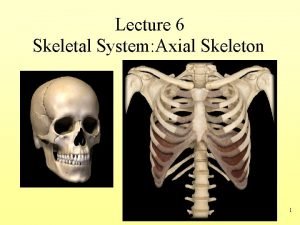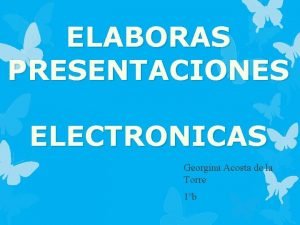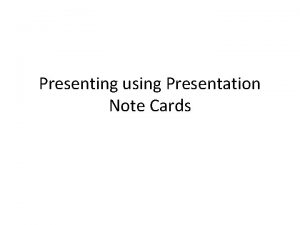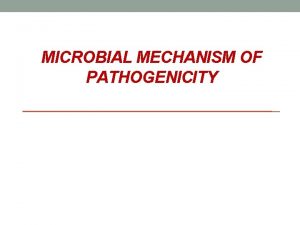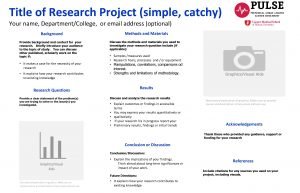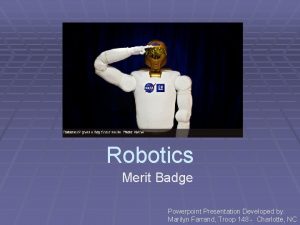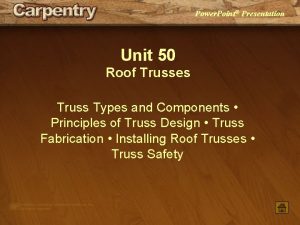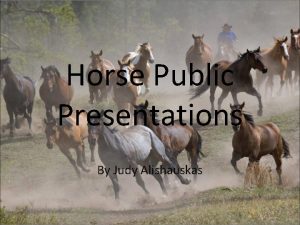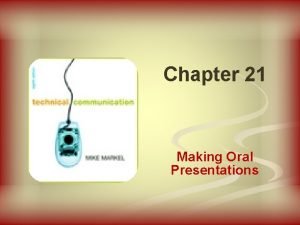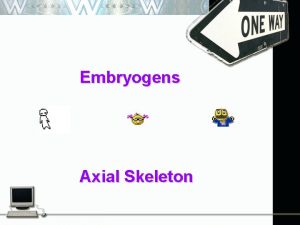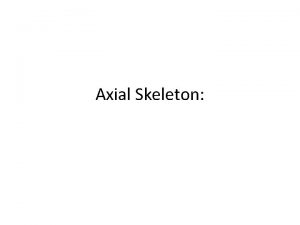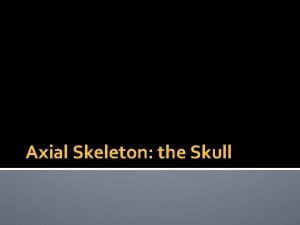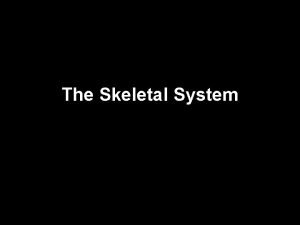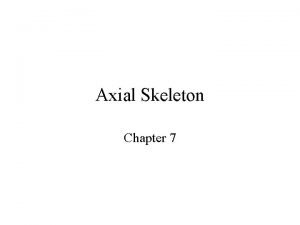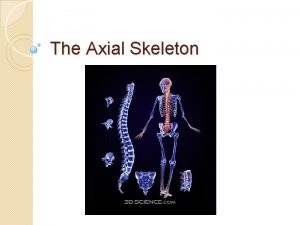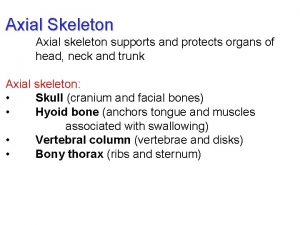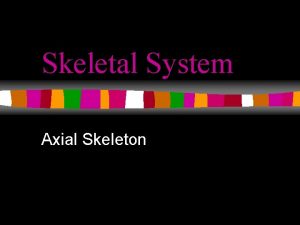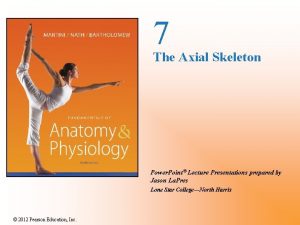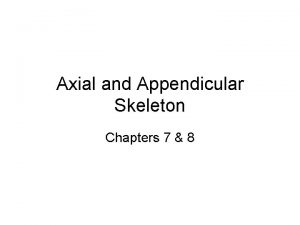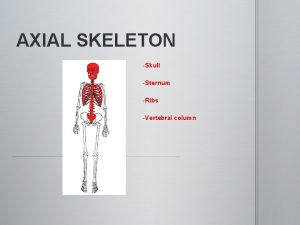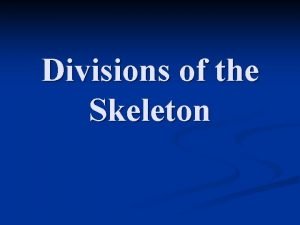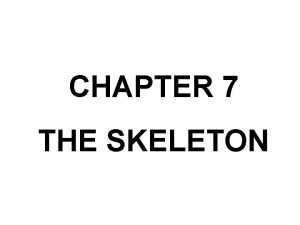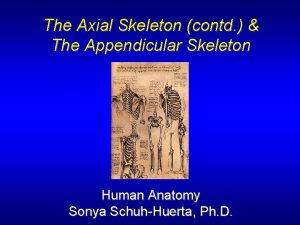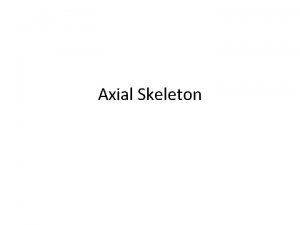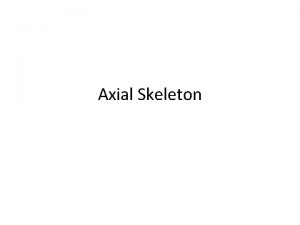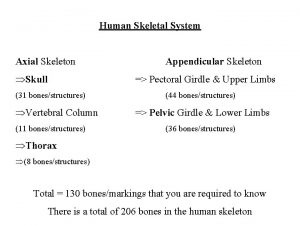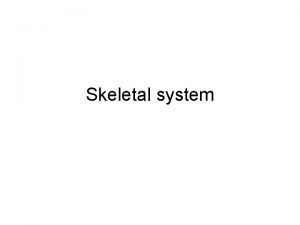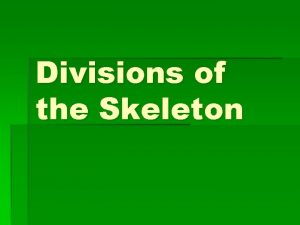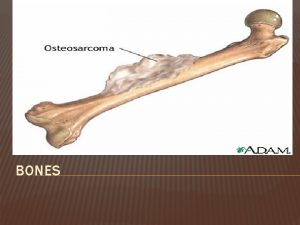7 The Axial Skeleton Power Point Lecture Presentations














































































- Slides: 78

7 The Axial Skeleton Power. Point® Lecture Presentations prepared by Leslie Hendon University of Alabama, Birmingham © 2014 Pearson Education, Inc.

Repition….

I. The Skeleton A. Bones, cartilage, joints, and ligaments 1. joints - also called articulations B. 206 named bones grouped into two divisions 1. Axial skeleton (80 bones) ► skull, vertebral column, and thoracic cage 2. Appendicular skeleton (126 bones) ► upper and lower limbs © 2014 Pearson Education, Inc.

II. The Cranium (Skull) A. The cranium is formed by cranial and facial bones 1. enclose and protect the brain 2. provide attachment sites for muscles of the head and neck B. Facial bones 1. Form framework of the face 2. Form cavities for sense organs of sight, taste, and smell 3. Provide openings for passage of air and food 4. Hold the teeth in place 5. Anchor muscles of the face © 2014 Pearson Education, Inc.

© 2014 Pearson Education, Inc.

C. Internally bony ridges divide skull into distinct fossae (surfaces) 1. anterior 2. middle 3. posterior D. Brain sits within the cranial fossae 1. brain occupies cranial cavity © 2014 Pearson Education, Inc.

Anterior cranial fossa Middle cranial fossa Posterior cranial fossa Superior view of the cranial fossae © 2014 Pearson Education, Inc.

E. The skull contains smaller cavities 1. middle & inner ear cavities—in lateral aspect of cranial base 2. nasal cavity—lies in and posterior to the nose 3. orbits—house the eyeballs 4. sinuses — air-filled spaces in bones around the nasal cavity © 2014 Pearson Education, Inc.

Sinuses of the cranium © 2014 Pearson Education, Inc.

F. The skull contains approximately 85 named openings 1. foramina, canals, and fissures 2. provide openings for important structures a. spinal cord b. blood vessels serving the brain c. 12 pairs of cranial nerves © 2014 Pearson Education, Inc.

IV. Cranial Bones A. Formed from eight large bones 1. paired bones a. temporal bones b. parietal bones 2. unpaired bones a. frontal bone b. occipital bone c. sphenoid bone d. ethmoid bone © 2014 Pearson Education, Inc.

V. Sutures A. Four sutures of the cranium 1. coronal suture - runs in the coronal plane 2. squamous suture - parietal bone meets temporal bone 3. sagittal suture - where right and left parietal bones 4. lambdoid suture – parietal bones meet the occipital bone © 2014 Pearson Education, Inc.

Cranium

right side of the skull Coronal suture Frontal bone Parietal bone Sphenoid bone Squamous suture Ethmoid bone Lambdoid suture Lacrimal bone Lacrimal fossa Occipital bone Nasal bone Temporal bone Zygomatic process Zygomatic bone Maxilla External acoustic meatus Mastoid process Styloid process Mandible Condylar process Mental foramen Mandibular notch Mandibular ramus © 2014 Pearson Education, Inc. Mandibular angle Coronoid process

right side of the skull © 2014 Pearson Education, Inc.

Frontal bone Parietal bone Supraorbital foramen Nasal bone Sphenoid bone Superior orbital fissure Temporal bone Optic canal Ethmoid bone Inferior orbital fissure Lacrimal bone Zygomatic bone Infraorbital foramen Maxilla Mandible Mental foramen © 2014 Pearson Education, Inc. Vomer

© 2014 Pearson Education, Inc.

Parietal bone Sagittal suture Lambdoid suture Occipital bone Superior nuchal line External occipital protuberance Inferior nuchal line Occipital condyle © 2014 Pearson Education, Inc.

© 2014 Pearson Education, Inc.

Maxilla Hard palate Palatine bone Infraorbital foramen Maxilla Zygomatic bone Sphenoid bone Vomer zygomatic process Styloid process External acoustic meatus Mastoid process Temporal bone Jugular foramen Occipital condyle Occipital bone External occipital protuberance Inferior view of the skull (mandible removed) © 2014 Pearson Education, Inc. Foramen magnum

Inferior view of the skull (mandible removed) © 2014 Pearson Education, Inc.

External acoustic meatus Zygomatic process Mastoid process Styloid process © 2014 Pearson Education, Inc.

Optic canal Lesser wing Foramen rotundum Greater wing Foramen ovale Sella turcica Body of sphenoid Superior view © 2014 Pearson Education, Inc. Foramen spinosum

Crista galli Cribriform plate with cribriform foramina © 2014 Pearson Education, Inc.

The Holes in the Head Optic foramen Foramen rotundum Foramen ovale Foramen spinosum Foramen lacerum Internal acoustic meatus Jugular foramen Hypoglossal canal Foramen magnum © 2014 Pearson Education, Inc. ▲

View Crista galli Cribriform plate Ethmoid bone Sphenoid Frontal bone Lesser wing Optic canal Greater wing Foramen rotundum sella turcica Foramen ovale Foramen spinosum Foramen lacerum Temporal bone Internal acoustic meatus Jugular foramen Parietal bone Occipital bone Foramen magnum Superior view of the skull, calvaria removed © 2014 Pearson Education, Inc. Hypoglossal canal

View Superior view of the skull, calvaria removed © 2014 Pearson Education, Inc.

The Sphenoid Bone Optic canal Lesser wing Foramen rotundum Greater wing Foramen ovale Sella turcica Body of sphenoid Superior view © 2014 Pearson Education, Inc. Foramen spinosum

Parietal bone Coronal suture Frontal bone Sphenoid bone Squamous suture Temporal bone Crista galli Nasal bone Lambdoid suture Occipital bone Ethmoid bone Vomer External occipital protuberance Maxilla Internal acoustic meatus Mandibular foramen Palatine bone Midsagittal section showing the internal anatomy of the left half of skull © 2014 Pearson Education, Inc. Mandible

Midsagittal section showing the internal anatomy of the left half of skull © 2014 Pearson Education, Inc.

Mandible Temporomandibular joint Coronoid process Mandibular notch Condylar process Mandibular foramen Ramus of mandible Mental foramen Mandibular angle Body of mandible Mandible, right lateral view © 2014 Pearson Education, Inc.

Mandible, right lateral view © 2014 Pearson Education, Inc.

Figure 7 -15 a Paranasal sinuses. Frontal sinus Ethmoidal air cells (sinus) Sphenoidal sinus Maxillary sinus Anterior aspect © 2014 Pearson Education, Inc.

Hyoid Bone © 2014 Pearson Education, Inc.

Figure 7. 17 The hyoid bone. Greater horn Lesser horn Body © 2014 Pearson Education, Inc.

XIII. Thoracic Cage Jugular notch Clavicular notch Manubrium Sternal angle Body True ribs (1 7) Xiphoid process False ribs (8 12) Floating ribs (11, 12) © 2014 Pearson Education, Inc. L 1 Vertebra Costal cartilage Sternum

XIII. Thoracic Cage L 1 Vertebra © 2014 Pearson Education, Inc.

Vertebral Column © 2014 Pearson Education, Inc.

The Vertebral Column A. In the adult, is formed from 26 bones B. Transmits weight of trunk to the lower limbs C. Surrounds and protects the spinal cord © 2014 Pearson Education, Inc.

Regions and Normal Curvatures A. The vertebral column has five major regions ► 7 cervical vertebrae of the neck region ► 12 thoracic vertebrae ► 5 lumbar vertebrae ► Sacrum - five fused bones ► Coccyx - inferior to sacrum © 2014 Pearson Education, Inc.

C 1 2 Cervical curvature (concave) 7 vertebrae, C 1 C 7 3 4 5 6 7 T 1 Spinous process 2 3 Transverse processes 4 5 6 7 Thoracic curvature (convex) 12 vertebrae, T 12 8 9 Intervertebral discs 10 11 Intervertebral foramen 12 L 1 2 3 Lumbar curvature (concave) 5 vertebrae, L 1 L 5 4 5 Sacral curvature (convex) 5 fused vertebrae sacrum Coccyx 4 fused vertebrae Anterior view © 2014 Pearson Education, Inc. Right lateral view

Regions and Normal Curvatures A. Curvatures of the spine 1. Cervical and lumbar curvatures ► Concave posteriorly 2. Thoracic and sacral curvatures ► Convex posteriorly kyphosis – exagerated curvature in thoracic region (humpback) lordosis – exaggerated curvature in the lumbar region scoliosis – S-shaped curvature of the whole vertebral column © 2014 Pearson Education, Inc.

Posterior longitudinal ligament Anterior longitudinal ligament Body of a vertebra Intervertebral disc Anterior view of part of the spinal column © 2014 Pearson Education, Inc.

Intervertebral Discs A. Are cushion-like pads between vertebrae 1. Nucleus pulposus a. gelatinous inner sphere b. absorbs compressive stresses 2. Anulus fibrosus a. outer rings formed of ligament b. inner rings formed of fibrocartilage c. contains the nucleus pulposus © 2014 Pearson Education, Inc.

Vertebrae © 2014 Pearson Education, Inc.

Lamina Posterior Spinous process Transverse process Superior articular process and facet Vertebral foramen Pedicle Body Anterior © 2014 Pearson Education, Inc. Vertebral arch

Posterior Anterior © 2014 Pearson Education, Inc.

Cervical Vertebrae A. Cervical 1. C 1 (atlas) no body, no spine 2. C 2 (axis) bifid spine, dens (head) 3. C 3 -6 bifid spine 4. C 7 non-bifid spine, first bulge in lower neck 5. transverse foramen (vessel+nerve) 6. bodies get larger in descending fashion © 2014 Pearson Education, Inc.

© 2014 Pearson Education, Inc.

Dens of axis Transverse ligament of atlas C 1 (atlas) C 2 (axis) C 3 Inferior articular process Bifid spinous process Transverse processes C 7 (vertebra prominens) Cervical vertebrae © 2014 Pearson Education, Inc.

Cervical vertebrae © 2014 Pearson Education, Inc.

C 1 – The Atlas Posterior C 1 Posterior tubercle Posterior arch Transverse foramen Lateral masses Superior articular facet Anterior arch Anterior tubercle Superior view of atlas (C 1) © 2014 Pearson Education, Inc.

C 1 – The Atlas Posterior C 1 Lateral masses Superior view of atlas (C 1) © 2014 Pearson Education, Inc.

C 2 – Axis C 2 Posterior Spinous process Inferior articular process Lamina Pedicle Superior articular facet Transverse process Dens Body Superior view of axis (C 2) © 2014 Pearson Education, Inc.

C 2 – Axis C 2 Posterior Dens Superior view of axis (C 2) © 2014 Pearson Education, Inc.

Thoracic Vertebrae A. Thoracic 1. long, inferior-directed spinous processes 2. transverse processes are long and heavy 3. T 1 superior whole facet : inferior demifacet 4. T 2 -8 two demifacets; superior large / inferior small 5. T 9 single superior demifacet 6. T 10 -12 whole facet for individual rib articulation © 2014 Pearson Education, Inc.

© 2014 Pearson Education, Inc.

Lumbar Vertebrae A. Lumbar 1. all have largest, thickest bodies 2. spinous processes are oblong and heavy © 2014 Pearson Education, Inc.

© 2014 Pearson Education, Inc.

Superior articular process Transverse process Spinous process Lumbar vertebrae © 2014 Pearson Education, Inc. Body Intervertebral disc Inferior articular process

Lumbar vertebrae © 2014 Pearson Education, Inc.

The Sacrum © 2014 Pearson Education, Inc.

Sacral promontory Sacral canal Ala Body of first sacral vertebra Body Facet of superior articular process Auricular surface Median sacral crest Transverse ridges (sites of vertebral fusion) Apex Anterior sacral foramina Coccyx Anterior view © 2014 Pearson Education, Inc. Lateral sacral crest Posterior sacral foramina Coccyx Posterior view Sacral hiatus

Anterior view © 2014 Pearson Education, Inc. Posterior view

Coccyx A. Is the “tailbone” B. Formed from 3– 5 fused vertebrae C. Offers only slight support to pelvic organs © 2014 Pearson Education, Inc.

The Thoracic Cage A. Forms the bony framework of the chest B. Components 1. thoracic vertebrae—posteriorly 2. ribs - laterally 3. sternum and costal cartilage - anteriorly C. Protects thoracic organs D. Supports shoulder girdle and upper limbs E. Provides attachment sites for many muscles of the back © 2014 Pearson Education, Inc.

Ribs A. All ribs attach to vertebral column posteriorly 1. true ribs—superior seven pairs of ribs ► Attach to sternum by costal cartilage 2. false ribs—inferior five pairs of ribs 3. floating ribs – ribs 11 and 12 © 2014 Pearson Education, Inc.

Jugular notch Clavicular notch Manubrium Sternal angle Body Xiphisternal joint True ribs (1 7) Xiphoid process False ribs (8 12) Intercostal spaces Floating ribs (11, 12) L 1 Vertebra Skeleton of the thoracic cage, anterior view © 2014 Pearson Education, Inc. Costal cartilage Costal margin Sternum

L 1 Vertebra Skeleton of the thoracic cage, anterior view © 2014 Pearson Education, Inc.

Superior costal facet (for head of rib) Angle of rib Body of vertebra Head of rib Intervertebral disc Neck of rib Tubercle of rib Shaft Crosssection of rib Sternum Costal cartilage Vertebral and sternal articulations of a typical true rib © 2014 Pearson Education, Inc.

Sternum Crosssection of rib Vertebral and sternal articulations of a typical true rib © 2014 Pearson Education, Inc.

Figure 7. 25 c Ribs. Articular facet on tubercle of rib Spinous process Shaft Ligaments Transverse costal facet (for tubercle of rib) Neck of rib Head of rib Body of thoracic vertebra Superior view of the articulation between a rib and a thoracic vertebra © 2014 Pearson Education, Inc.

Figure 7. 25 c Ribs. Superior view of the articulation between a rib and a thoracic vertebra © 2014 Pearson Education, Inc.

Sternum A. Formed from three sections 1. Manubrium—superior section ► clavicular notches articulate with medial end of clavicles 2. Body—bulk of sternum ► sides are notched at joints for costal cartilage of ribs 2– 7 3. Xiphoid process—inferior end of sternum ► ossifies around age 40 © 2014 Pearson Education, Inc.

Jugular notch Clavicular notch Manubrium Body True ribs (1 7) Xiphoid process False ribs (8 12) Intercostal spaces Floating ribs (11, 12) L 1 Vertebra Skeleton of the thoracic cage, anterior view © 2014 Pearson Education, Inc. Costal cartilage Costal margin Sternum

Fetal Skeleton A. Fontanelles 1. unossified remnants of membranes 2. soft spots in infant cranium © 2014 Pearson Education, Inc.

Fontanelles Frontal suture Frontal bone Anterior fontanelle Ossification center Parietal bone Posterior fontanelle Superior view © 2014 Pearson Education, Inc. Occipital bone

Infant Cranium Parietal bone Ossification center Frontal bone Sphenoidal fontanelle Posterior fontanelle Mastoid fontanelle Occipital bone Lateral view © 2014 Pearson Education, Inc. Temporal bone (squamous part)
 Appendicular vs axial bones
Appendicular vs axial bones Axial skeleton vs appendicular
Axial skeleton vs appendicular Jugular notch
Jugular notch Lecture presentations for campbell biology
Lecture presentations for campbell biology Chapter 5 the skeletal system axial skeleton skull
Chapter 5 the skeletal system axial skeleton skull Differentiate between axial and appendicular skeleton
Differentiate between axial and appendicular skeleton Figure 6-2 structure of a typical bone
Figure 6-2 structure of a typical bone Bone remodeling
Bone remodeling Mandibular foramen
Mandibular foramen Figure 6-4 the skeleton axial and appendicular divisions
Figure 6-4 the skeleton axial and appendicular divisions Chapter 5 the skeletal system figure 5-13
Chapter 5 the skeletal system figure 5-13 Lamina bone
Lamina bone Figure 5-13 is a diagram of the articulated skeleton
Figure 5-13 is a diagram of the articulated skeleton The axial skeleton contains
The axial skeleton contains Crash course skull
Crash course skull Axial skeleton concept map
Axial skeleton concept map Figure 6-4 the skeleton axial and appendicular divisions
Figure 6-4 the skeleton axial and appendicular divisions Axial skeleton
Axial skeleton C1 vertebrae name
C1 vertebrae name Axial skeleton
Axial skeleton Axial skeleton
Axial skeleton 01:640:244 lecture notes - lecture 15: plat, idah, farad
01:640:244 lecture notes - lecture 15: plat, idah, farad Ac power formula
Ac power formula Informsu
Informsu Point point power
Point point power Uses of vertical suspension
Uses of vertical suspension Power system dynamics and stability lecture notes
Power system dynamics and stability lecture notes Zline 667-36
Zline 667-36 Power semiconductor devices lecture notes
Power semiconductor devices lecture notes Switch mode power supply lecture notes
Switch mode power supply lecture notes Power system dynamics and stability lecture notes
Power system dynamics and stability lecture notes What is the point of uchendu’s lecture to okonkwo?
What is the point of uchendu’s lecture to okonkwo? The craft of scientific presentations
The craft of scientific presentations Mental health presentation titles
Mental health presentation titles Worst powerpoint presentations
Worst powerpoint presentations What are multimedia presentations
What are multimedia presentations Areas donde mas se utilizan las presentaciones electronicas
Areas donde mas se utilizan las presentaciones electronicas Developing oral and online presentations
Developing oral and online presentations Verbal support
Verbal support Tok presentations
Tok presentations World's worst presentation
World's worst presentation Business presentations bristol
Business presentations bristol Ria seminar system
Ria seminar system Boardworks presentations
Boardworks presentations Scqa analysis
Scqa analysis Internet presentations
Internet presentations Who is lazarus in the most dangerous game
Who is lazarus in the most dangerous game Note cards for presentations
Note cards for presentations The end pictures for presentations
The end pictures for presentations Useful phrases presentation
Useful phrases presentation Efficient elements
Efficient elements You exec
You exec Catchy titles for presentations
Catchy titles for presentations Catchy titles for presentations
Catchy titles for presentations Cooking merit badge powerpoint
Cooking merit badge powerpoint Customer service presentations
Customer service presentations Switch stacking concept
Switch stacking concept Bad powerpoint presentations examples
Bad powerpoint presentations examples Really bad powerpoint
Really bad powerpoint You exec
You exec Roof ppt presentations
Roof ppt presentations Https://creativemarket.com/
Https://creativemarket.com/ Horse topics for presentations
Horse topics for presentations Types of oral presentations
Types of oral presentations Hình ảnh bộ gõ cơ thể búng tay
Hình ảnh bộ gõ cơ thể búng tay Lp html
Lp html Bổ thể
Bổ thể Tỉ lệ cơ thể trẻ em
Tỉ lệ cơ thể trẻ em Voi kéo gỗ như thế nào
Voi kéo gỗ như thế nào Tư thế worms-breton
Tư thế worms-breton Chúa sống lại
Chúa sống lại Các môn thể thao bắt đầu bằng tiếng chạy
Các môn thể thao bắt đầu bằng tiếng chạy Thế nào là hệ số cao nhất
Thế nào là hệ số cao nhất Các châu lục và đại dương trên thế giới
Các châu lục và đại dương trên thế giới Công thức tính thế năng
Công thức tính thế năng Trời xanh đây là của chúng ta thể thơ
Trời xanh đây là của chúng ta thể thơ Mật thư tọa độ 5x5
Mật thư tọa độ 5x5 Phép trừ bù
Phép trừ bù độ dài liên kết
độ dài liên kết

